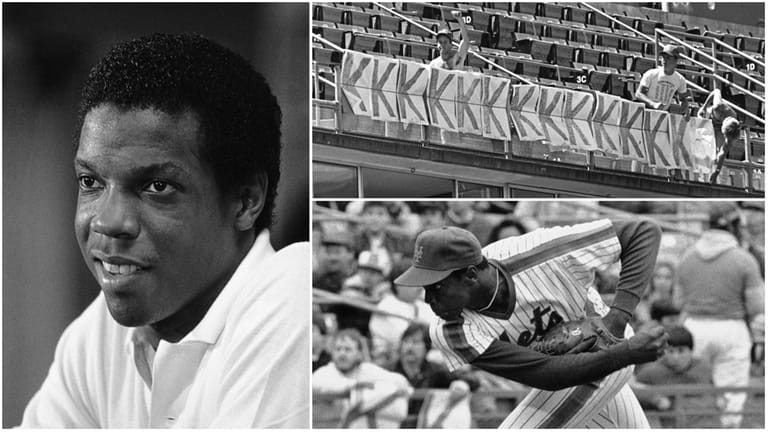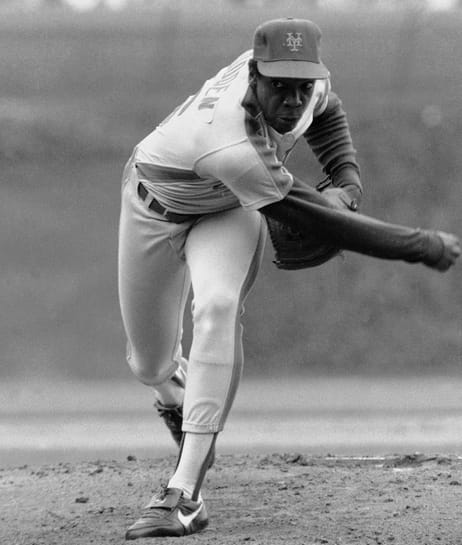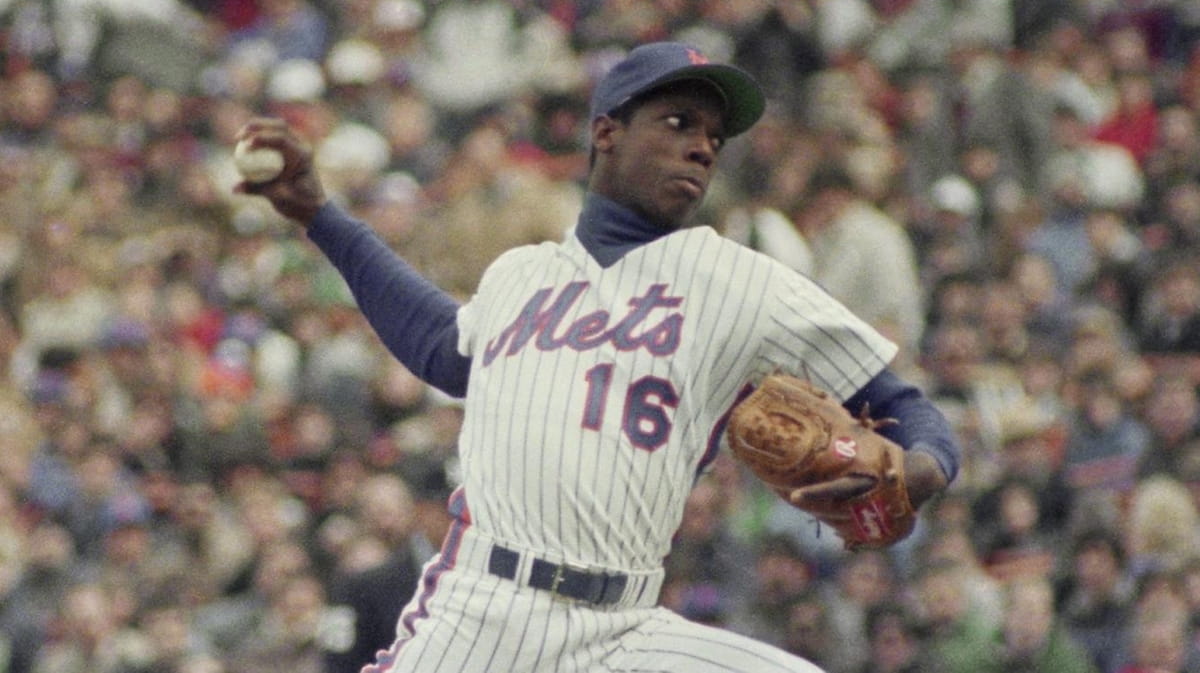When the Mets retire Dwight Gooden’s uniform number 16 on Sunday, it will be for his entire body of work during his 11 seasons with the club.
It’ll be for 157 wins from 1984-94. It’ll be for 23 shutouts. It’ll be for 2,169 2⁄3 regular-season innings and 1,875 strikeouts.
It’ll be for the 1984 National League Rookie of the Year award and the 1986 World Series championship and four All-Star team selections.
And it’ll be for Gooden’s 1985 season, which might have been the best season by a pitcher. Ever.
Gooden, who was 20 years old, went 24-4 with a 1.53 ERA. He made 35 starts and completed 16 of them. He pitched eight shutouts. He threw 276 2⁄3 innings and struck out 268 batters.
(Repeating the most amazing number of all: He was 20 years old.)
Gooden’s starts became a Shea Stadium event. His “Dr. K” nickname and the “K Corner,” which had sprouted the season before in the leftfield stands, became touchstones for a team on the rise.
A batter strikes out, fans put up another ‘K’ sign. So simple and so elegant.

Dwight Gooden had fans in opposing ballparks counting his "K's", as seen at San Francisco's Candlestick Park (top right). Credit: AP
The Mets won 98 games in 1985. There was no wild card, so after finishing three games behind the hated Cardinals in the NL East, instead of heading to the postseason, this Mets team headed into the offseason determined to come back better in 1986.
They did.
But Gooden was never better than in 1985.
“There were hitters — big-league hitters, really good hitters — that had no chance against Dwight,” former teammate Ron Darling said recently. “You know when you watch Williamsport, the Little League World Series, and you get the big kid who strikes out everybody because he’s just bigger than everyone else? That’s how Dwight was on some days.”
’You couldn’t get jealous’
You can look up the eye-popping statistics on baseball-reference.com or the back of Gooden’s 1986 Topps baseball card (which is available on eBay for $1.99 unsigned or about $100 signed).
But if you were there in 1985 — if you caught one of Gooden’s 35 starts, 18 of them at Shea Stadium — it was something you’ll never forget.
“From Day One, playing behind Doc, I had a front- row seat, man,” former Mets centerfielder Mookie Wilson said. “I could see everything. I saw it all. I was daydreaming a lot of times wondering what this guy, what this kid, was going to do next because every day was like an event. It was more than a ballgame. You just wait for him to do something special and you knew it was going to happen. Some guys struck out 10 guys, they had a great game. But that was normal for him. So it was no big deal. It was more about the way he went about doing his work. That was so impressive. I’ll be honest with you, I lost count [in centerfield]. Many days I didn’t know how many outs there were. I was just out there watching this guy.”
Darling had a pretty good year in 1985. The current SNY and TBS analyst went 16-6 with a 2.90 ERA in 36 games (35 starts).
“I pitched behind Doc,” Darling recalled, “and in those days you used to chart the pitches. So I was sitting on the bench. I had a good year. It didn’t feel like a good year when you charted Dwight Gooden. It made your year feel very pedestrian because he would strike out 12 on 94 pitches. It was the most incredible thing I’d ever seen.
“It was remarkable, and to be doing it at 20 was crazy. He was so far advanced. I was, what, 24 years old? [Darling turned 25 on Aug. 19.] He was so far advanced from what I knew about pitching, and I was four years older. It was so friggin’ good that you couldn’t get jealous. You couldn’t get mad. You just had to enjoy just like the fans did.”
Gooden’s home starts drew 722,290 to Shea Stadium, an average of 40,127. Memory being a funny thing, the mind wants us to believe there was a sold-out stadium every time Gooden pitched. There wasn’t, but there was a measurable uptick in tickets sold when Gooden was on the mound, a little more than 6,000 per game.
The Mets drew fans like crazy the entire season, to the tune of a then-franchise-high 2,761,601 — an average of 34,094.
Still, the memories linger — even if they are hyped a bit.
“In 1985, I can vividly remember, every fifth day that Doc started, we felt we had the day off,” reliever Roger McDowell said. “Doc had 16 complete games that year. We were overjoyed sitting down in the bullpen because we could just sit back, relax and enjoy the show like the other 55,000 or 60,000 at Shea.”
The Cy Young race
The largest crowd for a Gooden start at Shea in 1985 came on Sept. 11, when 52,616 showed up to watch the first-place Mets play the second-place Cardinals on a Wednesday night. The Mets were up by one game.
Gooden pitched nine innings, allowed no runs, struck out seven. If the Mets had scored one run, he would have finished the season with nine shutouts.
But the Cardinals’ John Tudor — who finished second to Gooden in the 1985 NL Cy Young Award voting — pitched 10 shutout innings.
The Cardinals scored a run in the 10th on Cesar Cedeno’s leadoff home run against Jesse Orosco. Tudor closed out his own 1-0 victory.
The teams were tied for first. The Mets went up again the next day with a walk-off 7-6 victory (before anyone had used the term “walk-off”), but they fell into second place for good on Sept. 14.
Gooden wasn’t done. After the Sept. 11 outing, his record stood at 20-4, his ERA at 1.68.
Tudor was 18-8 with a 1.87 ERA, so it wasn’t even clear if Gooden would win the Cy Young.
Gooden’s last four outings took care of that debate and vaulted his season into the ranks of the all-time top ones in modern baseball history.
In his final four starts — all while the Mets tried to catch the Cardinals — Gooden threw three complete games. The other start went eight innings.

1985 Cy Young voting results
1. Dwight Gooden, Mets: 120 points, 24/24 first place votes (24-4, 1.53 ERA)
2. John Tudor, Cardinals: 65 points (21-8, 1.93 ERA)
3. Orel Hershiser, Dodgers: 17 points (19-3, 2.03 ERA)
4. Joaquin Andujar, Cardinals: 6 points (21-12, 3.40 ERA)
5. Fernando Valenzuela, Dodgers: 4 points (17-10, 2.45 ERA)
6. Tom Browning, Reds: 3 points (20-9, 3.55 ERA)
7. Jeff Reardon, Expos: 1 point (2-8, 41 saves, 3.18 ERA)
Oh, and Gooden went nine innings and allowed no runs in his first two starts of September, including that heartbreaking 1-0 loss to the Cardinals on Sept. 11.
So in the final month-plus of the season, Gooden went 4-0 with a 0.34 ERA in six starts. In 53 innings — an average of 8 2⁄3 innings per start — he allowed two earned runs and 48 baserunners, striking out 49.
Tudor and the Cardinals went on to the NLCS and eventually lost to the Royals in the World Series.
On Nov. 18, Gooden got all 24 first-place votes and won his first Cy Young Award.
First and only. You know the whys of that story, how Gooden’s career went off the rails because of drug addiction, how he came back to New York with the Yankees to throw a no-hitter in 1996, how he was inducted into the Mets Hall of Fame in 2010.
A day to say thanks
Why retire Gooden’s number now? Because Mets owner Steve Cohen has decided to resume honoring club history — and the men who made it — after years of neglect by the previous owners.
Mets' Dwight Gooden and Darryl Strawberry on Oct. 7, 1985. Credit: Newsday/Paul J. Bereswill
So Gooden’s No. 16 goes up to a hallowed place in Citi Field alongside the Mets’ other retired numbers on Sunday. Darryl Strawberry’s No. 18 will join it on June 1.
There’s something so similar about Gooden’s and Strawberry’s stories. The young Black superstars who came up with the Mets, reached the heights of World Series champions in 1986, fell victim to addiction, resurfaced with the Yankees in later years, and now are getting their place in history with the Mets.
“Many times, the fans could have turned their backs,” Gooden said recently, “but they always gave me support even when I was down and even when I didn’t believe in myself. They always lifted me up. I think part of it is being honest with the fans. I made my mistakes. I admit it. I just tried to reach out and do the best I can. I’m not perfect. I’m never going to be perfect.
“I want to apologize to the fans for all the mistakes and my addiction off the field . . . Now I get the opportunity to thank the fans and let them know that every time I took the field, I gave it everything I had.”
Gooden, 59, gave credit to his teammates, including Hall of Fame catcher Gary Carter, who had joined the Mets in a crucial team-building trade from Montreal before the 1985 season.
“For me, once the season got going, I knew it was bigger than just a game when I was starting,” Gooden said. “There was more media attention. The games were sold out. And having Gary Carter catching me, that brought the best out of me.”
Mets pitcher Dwight Gooden, left, poses with catcher Gary Carter during a workout at Shea Stadium, Monday, April 8, 1985. Credit: AP/Ray Stubblebine
Carter, who died in 2012, marveled at catching Gooden in an October 1985 New York Times article.
“People are always asking me what the hitters say when he’s pitching,’’ Carter said. ‘’But they don’t say much. Once in a while, I’ll hear, ‘Wow, he really threw that one.’ That’s about all.’
‘’I’m even more impressed with him now, at how hard he throws and the control he has at only 20 years of age. It’s remarkable. It’s scary. He has two pitches, a fastball and a curveball. He gets them over with control and with good speed. But what really impresses me is his inner drive. With men on base, he tightens his belt. I haven’t seen him give in to a situation.’’
In that magical season, Gooden captured the heart of New York City and his own teammates. Thirty-nine years later, he still has it. That’s what Sunday will be about.
“There was a truly remarkable and humble way he carried himself,” Darling said. “It made you love Doc as a man and as a teammate. I can’t imagine anyone handling it better than Dwight did his first couple of years.
“Of course, the naysayers, the cynics, are going to say, ‘Well, he was doing this and that.’ All I know is on the field, the greatness combined with humbleness that he exhibited, the friendly way he was with fans and media, the teammate he was — all of that was A-plus. It really was.
“That’s why I think to this day all of us have empathy, and as we’ve gotten a little smarter about addiction and disease, I hope that will make us all empathetic. It’s a very democratic thing. Doesn’t matter if you’re rich, poor or the greatest pitcher on the planet.”
Best year ever?
Was Dwight Gooden’s 1985 season the best by a starting pitcher in modern baseball history?
Depends – do you consider Walter Johnson and Cy Young as part of modern baseball history?
According to baseball-reference.com, Johnson had the best pitching seasons as determined by WAR (Wins Against Replacement).
Johnson’s 1913 (36-7, 1.14 ERA for the Washington Senators) was worth 15.1 WAR. His 1912 (33-12, 1.39) was worth 13.2.
Next is Young’s 1901, when he earned 12.5 WAR by going 33-10, 1.62 for the Boston Americans.
Next is Gooden, 1985, playing in what everyone would agree was a totally different sport than in 1901 or 1912-13.
Gooden’s WAR for that season was 12.2, just a sliver ahead of Steve Carlton’s 1972 season with the last-place Phillies. Carlton earned a 12.1 WAR by going 27-10 with a 1.97 ERA.
You might wonder about Bob Gibson’s 1968 performance in the “Year of the Pitcher.” Gibson went 22-9 with a 1.12 ERA, good for a 11.2 WAR.
Another memorable local season was the one Ron Guidry had for the Yankees in 1978. Guidry went 25-3 with a 1.74 ERA, won the AL Cy Young and finished second in the MVP voting. His WAR was 9.6.


